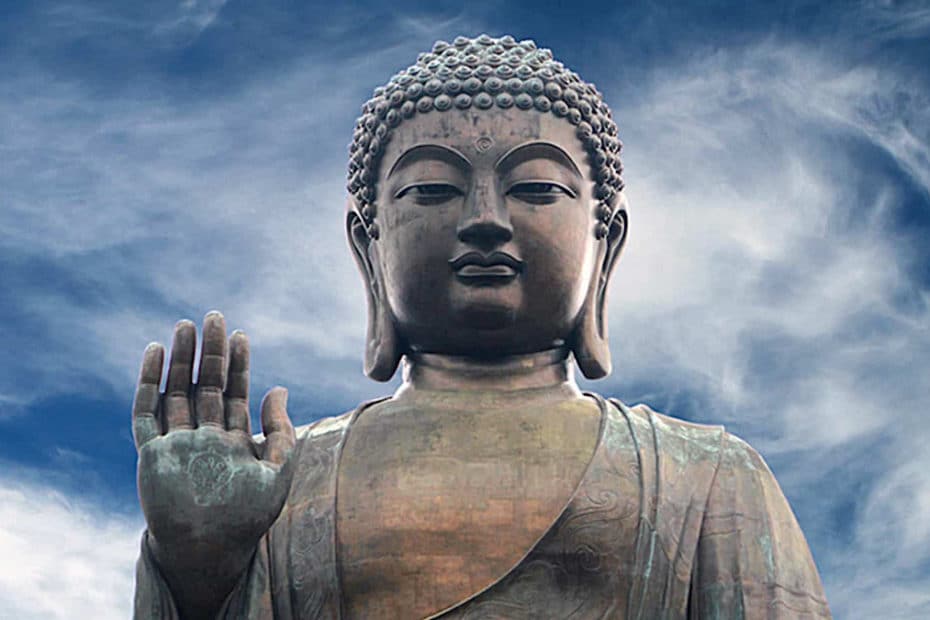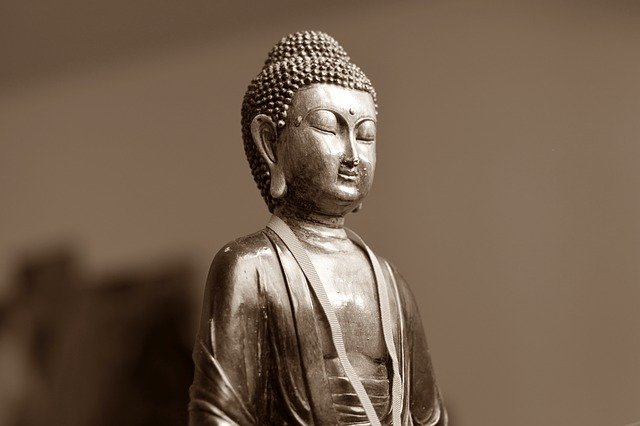We are going to reflect on the Four Noble Truths today. Wednesday 26 May is Vesak Day and one of the most important Buddhist holidays. It was the day the Buddha was born. He was enlightened and he also passed away, it’s not all on the same day but it was a full moon day in the month of Vaisakha the fourth lunar month which is usually in May or the beginning of June.
On that day, he reached enlightenment in Bodh Gaya under the Bodhi tree. After he attained enlightenment, the Buddha said he wanted to pass on that knowledge but no one would understand it. It was said that the king of the devas or angels – Indra and the king of the Brahmas Sahampati who persuaded the Buddha, “Please, give your teaching. There are some beings out there who are not as deluded (do not have that much dust in their eyes), they will understand.” Then Buddha decided to teach and he contemplated about who he should first give his teachings to because it’s important that those people would understand.
Then the Buddha thought of the five ascetics that were practising with him when he was performing severe asceticism and nearly starved to death. They left him because they thought the Buddha had given up because he had begun to eat again. These guys, the Buddha thought, might understand. So, he went to look for them and they were in Varanasi along the Ganges River and he gave his first sermon.
This first sermon was the Four Noble Truths – it is the heart of the Buddhist teaching. All the other teachings, surround or lead to this teaching. This is really the heartwood of the Buddha’s teaching. Once he was asked what he was teaching by another ascetic, he said I only teach suffering, the cause of suffering, the cessation of suffering, and the path that leads to the cessation of suffering. These are the Four Noble Truths.
Exploring the Four Noble Truths
The First Noble Truth is suffering. Some people don’t like this word. They think they are not suffering. Many people have a good life and they think that they have no suffering. I have many students who come to the temple and say they are not suffering. We could also call it not being well, like your mind is not at ease. Things are not the way you like them to be. There is a cause to it. The cause of not being well or fully satisfied. Then there is the truth of the cessation of suffering – nirodha1. That’s the end or the cessation of suffering.
Then there’s the Eightfold path that leads to the cessation of not being well. Some people asked why are the truths being explained this way – first is the suffering, then the cause of suffering, then the cessation of suffering, and the path leading to the cessation of suffering. They said cessation should be the last one. But no, it’s the third one and the last is the path. It’s because the Buddha has been compared to a physician who sees a patient. The doctor identifies the disease, analyses the cause for the suffering, which is very important. And then, the way to heal the sickness and the path is the prescription the doctor gives to the patient.
What is Suffering?
The obvious kind of suffering is birth. Birth is not comfortable. Then there is sickness, which is something we don’t like. Old age is suffering. Death is suffering. Death is not nice. These are very obvious. The Buddha himself saw it when he was a Bodhisattva as a prince. He saw divine signs (devaduta1) – a sick man, an old man, and a corpse. He was very shocked when he saw them because he was kept from seeing suffering by his father. He had three palaces for every season and all kinds of pleasures. His father knew from a Brahmin when Siddhartha was born that he would either be an emperor or the Buddha. The king wanted his son to be a king and kept the Buddha from the scenes of suffering.
But the Buddha sneaked out of the palace one day and saw the signs and it cut his heart deeply. He was distraught by it. That’s why he decided to overcome all suffering. We see suffering every day. Things that are not satisfying for us. We don’t get things we want to have and we get things we don’t want. We are separated from those we love, especially now in the pandemic, we don’t see friends or families. Then we are connected to those we dislike like colleagues or neighbours who are difficult. This is also suffering.
Every kind of depression and physical pain is not making us happy. If we get what we want, we are happy for a moment and then get bored. It’s not like you can hold on to happiness forever. It is passing and impermanent. It is suffering.
The Cause of Suffering
Then we have the cause. Why is there suffering? The cause is attachment or tanha in Pali. Craving, clinging, and attachment. We hold onto things such as more and more happiness. Then there is the attachment of disliking – the anger, the hatred – the things we don’t want. We have hatred, anger, and disappointments – these are the causes of suffering.
The deeper cause is our ignorance, our not-knowing. Not being clear about the Dhamma or knowing the true nature of things. We have this ignorance of this Self – the ‘I’ who wants this and ‘I’ who don’t want that. Ignorance is the first cause because without ignorance there won’t be anger or desire arising. These kilesas1 or defilements are the cause of all suffering.
The Truth of the Cessation of Suffering
The truth of the cessation of suffering is that suffering can cease. Sickness (of the mind) can be overcome, it can be healed.
The Path leading to Cessation of Suffering
There is the path that we can take to overcome suffering – that’s the Noble Eightfold Path. It’s the Dhamma Wheel with eight spokes, that’s the symbol for the Noble Eightfold Path. It’s also known as the middle way, which means avoiding extreme sensual indulgence and avoiding extreme austerities. The Buddha enjoyed sensual pleasures before he reached enlightenment and tried austere asceticism to overcome suffering. He realised the path of asceticism could not lead to the end of suffering because he almost died and had not reached enlightenment yet.
One day, when he was sitting under a tree near the river, he heard a music teacher and his pupils passing by on a boat. The teacher taught his students how to play the sitar. The Buddha heard the teacher say to the students – if the strings of the sitar are too loose, there is no pleasant sound coming from it. If the strings are too tight, they will break. Then the Buddha understood, “That’s what’s going on with my practice. If there is too much asceticism then the body will break and die. If one is too loose indulging in sensual pleasure, then there are no results.” So, he understood this middle way.
The Noble Eightfold Path
The Noble Eightfold Path begins with wisdom, which is Right View and Right Thought. Right View is samma-ditthi1. Right View is always having an understanding of what you call, yourself – this problem-making self. What is it really? There are these five aggregates of existence. These five are the body, feelings, perception (memory and concepts), mental formations, and consciousness. These five are what we identify as the Self. Right View can see these five aggregates and the Four Noble Truths – the suffering, cause of suffering, cessation of suffering, and the path leading to the cessation. This is the first part of the Noble Eightfold Path.
The second one is Right Thought – thinking in the correct way. It means seeing the tilakkhana1 – the three characteristics of existence. The three characteristics are applied to the five aggregates and they are impermanence, suffering – not satisfying and not under our control – not-self. These three are also known in Pali as anicca, dukkha, and anatta1. They are to be contemplated again and again. We really apply it when we practice meditation.
The second part of the Noble Eightfold Path is sila1 or ethical principles such as right action – avoid killing and harm towards other sentient beings and self. There’s not stealing – not taking things without asking. Not having sexual misconduct – any sexual misconduct that causes suffering to others such as cheating on your spouse or other people’s spouse. Or if the partner is too young. Then there is right speech. There are four speech opposite to right speech – lying, divisive speech to separate people, harsh speech, and senseless speech.
There is also right action, which is right livelihood – earning your daily living without causing suffering. Such as not killing animals or selling weapons, drugs, or human trafficking. These are wrong livelihoods. These are the ethical principles in the Noble Eightfold Path.
The third part of the Eightfold path is the meditation path. The first is Right Effort. We should make the right effort to let wholesome thoughts, speech and action arise in the heart and the mind. Feed and nourish these wholesome things if they have arisen. Enjoy doing wholesome deeds. Next is to avoid unwholesome thoughts, speech, and action. If unwholesomeness has arisen in the heart and mind, try to reduce by letting go of it.
The third part of Right Effort is purifying your mind. It is the higher part where you stand above both. It’s always important to create wholesome things as it will support you in the practice while unwholesomeness will drag you down. But the higher level of right effort is standing above good and bad and this is a deep level of equanimity.
The second part of the meditation path is Right Mindfulness – samma-sati1. Right Mindfulness is always applied to the presently arising object. Whatever arises in the present moment, you know it, you are aware and you observe. It also means you use samma-sankappa1 which is Right Thought to the object that your mindfulness knows in the present moment. That means you know the object is impermanent and not satisfying because it changes, also because it cannot be controlled. The object is not myself because it is not under my control. So, you see the three characteristics of everything in your experience. We have to apply it in our mindfulness training.
Sometimes people mistake mindfulness as watching the rising and falling of the abdomen as vipassana1 (insight or contemplation). Actually, this is a concentration practice. Only if you apply this knowledge on the rising and falling and see the true nature of the breath, then it is vipassana. So, it’s concentration (samatha1) that brings your mind to the present object, the mindfulness (sati) of knowing it, and sampajanna1 (clear comprehension), the understanding of it so that wisdom can arise. This would be samma-sati – Right Mindfulness.
The next part is Right Concentration. This means bringing enough focus in your mind to raise Right Mindfulness. Some people say samatha practice does not do anything or bring about wisdom, but you need it too. There is no way to practice vipassana without concentration. For those who practice daily meditations with me, you know it already. I build it up in this way. We first practice concentration for a few minutes to be with the breath to calm the mind. To let go of thoughts. Only then we open up and practice more of seeing the present moment and object. For most, it is not possible to go straight to the present object unless you have practiced for a long time. You may get lost and get involved in thoughts again. So, you need a certain amount of concentration to do that.
This is the Noble Eightfold Path and it’s the medicine the Buddha gave to end suffering. There is one more thing I want to mention. I usually like to mention the Four Noble Truths in an easy and simple way. There is suffering and I know suffering comes from holding on. Holding on causes suffering. There is the cessation of suffering and that also has a cause. The Buddha’s teaching is always about cause and effect. Cessation of suffering has a cause, which is letting go. Let go and suffering ceases. Try it out. Do you want to walk the path of suffering? Hold on as much as you can, very easy. Get as attached as you can, you will suffer 100%.
If you prefer freedom from suffering, then train the mind to let go. The Eightfold Path is the way to do that. There is the path to the cessation of suffering and the path of suffering. If the Eightfold Path leads to the cessation of suffering if you practice it in an opposite way – such as starting with Wrong View. You have wrong views of things. Not seeing the true nature of things, not seeing the five aggregates or the Four Noble Truths, this leads to suffering. Wrong Thought is not seeing impermanence and it leads to suffering. If you see in the wrong way, you experience suffering. If you think and you suffer – you know, “I was caught up in wrong thoughts again.” Bring this wisdom and knowledge you have and apply it to the present situation. What went wrong? Where is the wrong thinking? Then you can reach the cessation of suffering. You can choose to tread the Noble Eightfold Path or its opposite.
1 Pali is the language used in the Theravada Buddhist Canon. It is an Indic language closely related to Sanskrit and was developed in Northern India in 5th to 2nd century BC.



